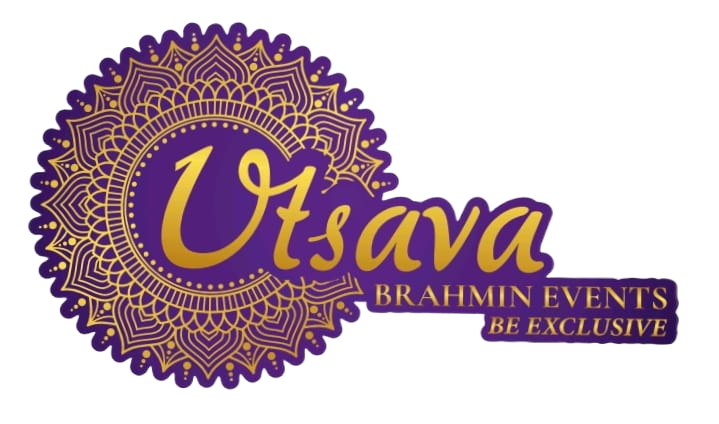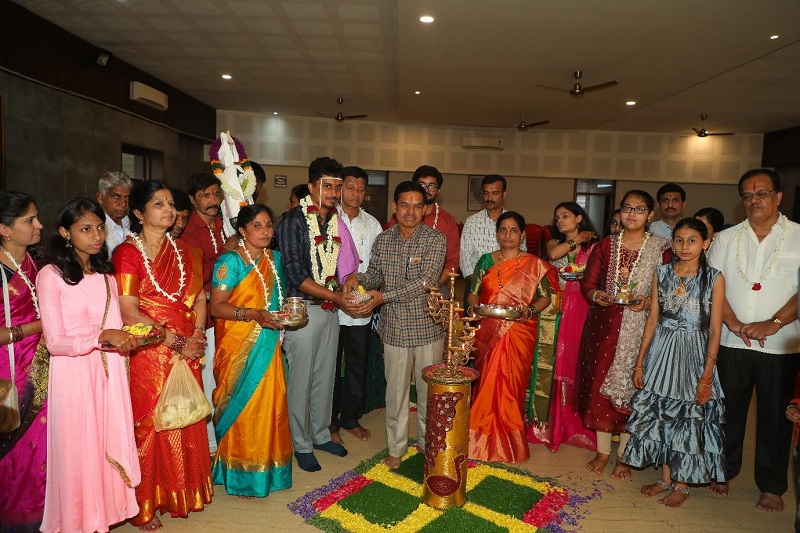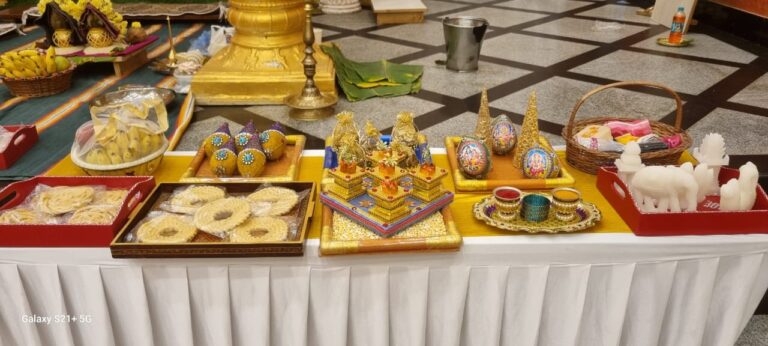Varapooje
Varapooje in Brahmin Wedding
The Varapooje ritual is an important and symbolic part of many traditional Indian weddings, especially in South India. It marks the formal welcoming of the groom into the wedding venue or the Mantap (the stage or altar for the wedding ceremony). Here’s a more detailed description of the ritual:
- Welcoming the Groom and His Family: The groom, along with his family, is formally welcomed to the wedding venue. This is done by the bride’s family, and the welcoming is often accompanied by the tradition of exchanging garlands. These garlands are placed on the groom and his family members as a gesture of respect and goodwill. This is a heartfelt moment as it signifies the union of two families.
- Bride’s Father Holds the Groom’s Hand: The bride’s father, a key figure in the wedding, holds the groom’s hand and leads him into the Mantap. This moment signifies the acceptance of the groom into the bride’s family and is symbolic of the passing of responsibility and blessings from the father to the groom.
- Grand Flower Path (Modern Ritual): In modern times, a beautiful, decorative flower path is often created for the groom’s welcome. The path is laid out with flowers, and it provides a grand visual effect as the groom walks down the aisle. Traditionally, the bride’s father accompanies the groom, and they walk together down the center of the flower path.
- Lighting the Lamp: The groom and the bride’s father light a ceremonial lamp at the center of the Mantap. The lighting of the lamp is highly symbolic, signifying the beginning of the wedding rituals. It represents the illumination of the path ahead for the couple as they embark on their marital journey, bringing light and positive energy into the ceremony.
This ritual not only marks the beginning of the wedding festivities but also symbolizes the unity of two families and the start of a new chapter in the lives of the bride and groom. It blends tradition with modern elements, creating a memorable and auspicious moment for everyone involved.
Meaning of Varapooja:
- Varapooja is a reaffirmation of the engagement, performed a day before the wedding.
- The ritual involves reconfirming the consent of both families for the marriage.
- The Lagnapatrike (marriage agreement) is read out again in the presence of elders and the family deity.
- This ceremony reinforces the mutual agreement and blessings for the couple’s union.
As the ceremony unfolds, the two families gather with smiles and warmth, exchanging gifts like fruits, flowers, and sweets. It’s not just about the items—they’re symbols of respect and a promise to grow closer as one big family.
The usual list of items given by grooms mother to the girl during Varapooja is as below:
- Dry Coconut Carvings
- Dry Fruits
- 5 types of Fruits
- Sweets
- Doll Sets to depict the rituals
- Halid, Kumkum with bangles and flower
- 5 Coconuts
- 5 Bella(Jaggery mould) with fried channa gram(Hurigadle)
- Chakli – fried eatble items with bigger size for display
- Puffed Rice Balls (Puri Unde) in bigger size
List of Items from Bride side to Groom side during Vara pooje is as below:
- Dry Coconut Carvings
- Dry Coconuts cut in halves with sweets
- 5 types of Fruits
- Dry Fruits box
- Sweets
- Boy & Girl Dolls
- Chakli & Puri Unde items
- Cosmetics
- Sugar Moulds (Sakkare Acchu)
The list of gift exchanges during varapooja can go on endlessly, tailored to individual preferences—whether simple, grand, or eco-friendly. The true essence lies in the joy of celebrating and sharing, with the focus on the heartfelt spirit of giving and receiving.
The atmosphere feels magical, with traditional food beautifully arranged and colorful decorations lighting up the space. Laughter and chatter fill the air as everyone takes in the festive spirit, celebrating the union of two families and the beginning of a beautiful journey for the bride and groom.
As the ceremony ends, the bride and groom exchange rings, symbolizing their love and commitment. Sweets are shared, spreading joy and gratitude as both families come together to celebrate the couple’s union and the blending of their traditions.




